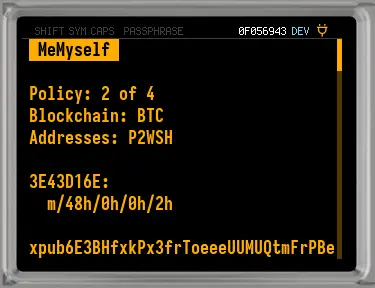Advancement of the hardware wallet standard and aesthetics for cypherpunk. CoinkiteA small Bitcoin-based company from Canada is now the industry’s third biggest manufacturer.
Coinkite, a hardware wallet that only supports Bitcoin, has opted for a different strategy. They have stayed true to the Bitcoin platform and are seeing success.
“Coldcard is the ultimate HODL device — nobody else offers 10% of the features we have, and it’s all designed for Bitcoin. You literally cannot fork Coldcard for altcoins,” Exclusive interview with Rodolfo Novak of Coinkite, the cofounder and CEO.
“Coinkite is like a race car company or a specialty car company—a small team that makes something really, really good and has a market. Bitcoiners recognize it.”
The product is a “security autism,” Coinkite, as he said, is one of the oldest Bitcoin companies, having been founded in Canada in 2013 You can also read about how to get in touch with us. Rodolfo and Peter Gary.
What is the secret to Coinkite’s success? With less than twenty employees they have become third in hardware wallet manufacturing and are not even involved with meme coins.
Cypherpunk Aesthetics
Coldcard’s transparent casing embodies the aesthetics of Bitcoin cypherpunk. Instead of concealing their hardware, they show it off. It’s not for style or show, but to ensure functional security.
“The transparent case allows users to see the hardware directly, verify that there are no external devices attached, things that might compromise the device,” Rodolfo explained. “We want people to be able to see it — it’s all functional.”
It is important to note that the word “you” means “people”. Coldcard QThis latest generation device has the same hardware, codebase, and keyboard as their older Coldcard Mk4. It also adds some new features for better quality of life, such as a larger keypad, external battery input, and an independent camera module equipped with lasers that scan the smallest QR codes.
It feels similar to a Game Boy Color from the early 2000s. But it looks as if Sarah Connor had thrown down with this device.
“[Users] can easily scratch off the USB wires, to satisfy certain use cases and threat models,” Rodolfo explained the options that the device provides.
The whole architecture, including every chip and wire, is visible, which demonstrates their dedication to quality. “don’t trust, verify” ethos.
It’s intimidating looking at it at first. And the Q is usually considered an intermediate device. But its default settings allow anyone to easily use it.
Coinkite does not compromise critical security features for the user’s experience. Coldcard Q has an LCD display that is simple, low-power, without touch, with a minimal amount of hardware complexity. The module was chosen in order to keep Coldcard Q as a device which can be powered by double AAA battery. Coinkite opted to not use Bluetooth, which would have enabled new connectivity and user experiences, but is notoriously unsafe.
Coinkite is not integrated with altcoins. By avoiding their complexity and security concerns, they also reduce the potential client base.

Recently, the Bybit hack showed that this Bitcoin-only strategy was effective. billion dollars Hackers stole ETH from an exchange whose employees were using it various hardware walletsSafe web wallet, through a compromised dependancy. Exchange executives say they accidentally signed the compromised block of hex-code that was the smart contract of their multisig. They effectively blind signed away billions worth of coins.
Bitcoin has avoided this type of complexity because it is extremely cautious. Bitcoin transactions which would be able to move millions of dollars are simpler, on-chain and only require users to confirm amounts, recipients addresses and change addressees, instead of fully fledged Solidity Smart Contracts.

Source Available
Coinkite’s commitment to transparency and verification goes beyond the hardware. They have released their firmware and software as open source from the start. full schematic of their security products.
“Since version one, we always released schematics so people can go and build it themselves and prove the things. Because the whole point for us is provability. Every claim we make, we need to be able to substantiate in a way that the user can prove it themselves.”

Rodolfo said that these devices can be purchased off the shelf for those who are security-conscious and want to make sure they have nothing to fear.
“Some of these claims require you to be extremely advanced. But the point is somebody out there can go and prove it, right? And people do,” He also added.
The licensing of Coldcard has been criticized by some as not being truly open-source. Coldcard’s codebase was initially released under GPL, was transferred to MIT In response to a competitor that cloned and released a similar device, a 2021 commercial restriction was imposed.
Rodolfo was unapologetic when asked to comment on the subject. Normally a light-hearted and cheerful Canadian, Rodolfo’s passion for this topic could be felt.
“So we believe in, well, first of all, we don’t like assholes. And you can put that in the article. We’re functionally adversarial. That’s just our mindset. That’s with the code. That’s with the hardware. That’s with the law. Somebody went out there and, without mentioning to us, without anything, just took the code, didn’t even bother to change anything, contribute back, zero contributions back, and started a competing company. So we’re like, you know what, fuck you. And we changed the license.”
The Bitcoin community is often criticized for taking a rare position in open source. “open source” It is not a problem in itself, but rather a matter of ensuring that “source available.”
“So we used to be GPL. And then we changed to MIT, which is even more open than GPL is. But we added a commercial clause. So anybody can copy our code, change our code, gift our code, use our code however the fuck they want. The only restriction that they have is they cannot start a competing business,” Rodolfo explained.
Some critics claim that the lack of commercial incentives to examine the code limits the review process for open-source programs. They also argue this reduces their security.
Rodolfo, however, calls this a story. He says that after the incident, sales had tripled, exchanges around the globe use Coinkite’s products to safeguard customer funds, companies hire professional coders to comb over all the codes, as do OGs.
“There are exchanges who use our devices as part of their internal co-signing systems. There are a lot of OGs who use our devices with a lot of money in them. And we learn a lot from a lot of private conversations on attacks, on how people are using it—We get a lot of very interesting private emails with people who check the firmware every time we make an update, people who check the hardware, people who check everything.”
Forged in Chaos
Coinkite’s early roots are in the Bitcoin market, which explains their focus on making devices that can be verified to the core.
“We wanted to do Bitcoin payments. We had the first Bitcoin payment terminal with Bitcoin debit cards and stuff like that,” Rodolfo remembered the early days of Bitcoin and Coinkite.
“But there weren’t any good wallets. And so we launched essentially a crypto bank for people to store funds. And then it became the multisig web wallet. I think at that time there was about $4 billion worth of bitcoin in the system. It was like 2014.”
Coinkite.com launched one of the industry’s first multisignature wallets, allowing users to manage multiple key devices with Trezor and Ledger hardware. Users were able to sign transactions in a wallet that offered the flexibility and tools advanced users demand today. “It was like BitGo before BitGo,” Rodolfo spoke about their 2014 web wallet, which they closed after just two short years.
The aforementioned is a blog post The time title “Time To Be Your Own Bank,” Coinkite explained that the closing of the web wallet was a pivot which would ultimately lead to the Coldcard.
“Being a centralized bitcoin service does attract attention from state actors and other well-funded pains in the butt, and as a matter of fact, we’ve been under DDoS since the first month we launched—over three years—yay. Plus we have put real fiat dollars into our lawyers’ pockets, to defend our customers from their own governments. This is not what we love to do, which is coding and delivering awesome services.”
The Bitcoin industry also saw the death of user-friendly wallets, centralized exchanges, and web-based exchanges. Bitcoin’s cybersecurity was a paradigm shift, but it wasn’t the only one. Digital money transactions that were irreversible had not been possible before. The regulatory uncertainty faced by these companies was extreme.
“We didn’t want to be in the business of holding people’s bitcoin, we wanted to empower users to hold their own keys, so we pivoted to focus on making the best hardware wallet we could.”
Coinkite shut down its web wallet in 2016, but they didn’t stop there. They launched one of the most popular products. Opendime.

Opendime is a new way of storing bitcoins in physical devices without trusting anyone.
The Opendime, still in use today, features a hardware seal that generates the private keys from initial user input, but in a chip that does not reveal the private key to the user — only the corresponding public key. The device’s physical seal must be broken in order to see the key or spend any bitcoin that is sent. There will also be visible signs of tampering, such as a flashing red light and evidence.

Opendime is inspiring a new generation of Bitcoin-based artists to incorporate these devices within physical works, like artwork. Madex The following are some examples of how to get started: Johnny DollarThe device is often decorated with a balance in bitcoins.

Perhaps their most famous device is the Blockclock. This is one of only 500 ever produced. “electro mechanical” The time machine is a tribute to the 10th anniversary of Bitcoin.
These 500 units were sold “Quick!” Rodolfo said to Bitcoin Magazine that he hit the market with 1 BTC for each customer in late November 2018. This is just one month following the release of Satoshi’s Bitcoin White Paper. At the time, bitcoin was worth approximately $4,000.
Two smaller versions were released, which clearly targeted mass-consumption at lower prices. Blockclock Mini Then, there is the Blockclock Micro.

Coinkite was founded in 2003 and has since created many technologies both digital and physical. Some of these have been open-source and serve essential parts of the market. Rodolfo, when asked to count the number of websites they had created, laughed, and said that he didn’t know.
Let’s just end with some of the greatest hits.
- BBQr — high-security QR code protocol, backwards-compatible with normie standard.
- Bitcoin Security Guide — a noob-friendly step-by-step Bitcoin self-custody guide.
- Bitcoin Treasuries — a website that tracks the biggest public holders of bitcoin.
- Bitcoin Binaries bot — a bot that automatically builds critical Bitcoin software releases from source, looking to verify that the end result is the same packaged product normal users download.
- Check MSG — a simple site that verifies the cryptography of messages signed with Bitcoin key pairs.
- NFC PushTX — a simple protocol to send Bitcoin transactions from an air-gapped device like Coldcard to a web-enabled device like a phone, and then to the web.
- Bitcoin.Review Podcast — easily one of the best Bitcoin podcasts for technical Bitcoiners, especially those that suffer from insomnia.
“DagelijksCrypto is not responsible for any activities you perform outside DagelijksCrypto.”

